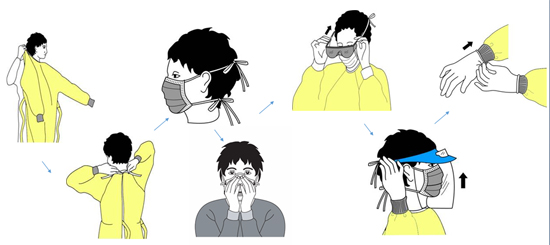Barrier nursing
- Introduction...
- 1. Background...
- 2. Learning object...
- 3. Barrier nursing...
- 4. Universal preca...
- 5. Cohorting...
- 6. Body substance ...
- 7. Donning Persona...
- 8. Personal protec...
- 9. Removing PPE...
- 10. Removing PPE- ...
- 11. Airborne preca...
- 12. Summary...
 |
 |
Introduction
DR. SHIV SAJAN SAINI
MD, DM (Neonatology)
Assistant Professor
Department of Pediatrics
PGIMER, Chandigarh
1. Background
► Routinely infected neonates
♦ Universal precautions
► Under certain situations - more stringent measures needed
♦ Highly contagious infections
♦ Multidrug resistant organisms
♦ Immuno-compromised patients
► Barrier nursing is a set of interventions consisting of
stringent infection control practices so as to prevent
spread of infections in such situations
2. Learning objectives
► The concepts of barrier nursing
► Contact prevention
► Personal protective equipment
► Respiratory prevention
3. Barrier nursing concept
► Set of interventions
♦ Stringent infection control practices
♦ Prevents spread to other neonates/ healthcare workers
► Spread of infections through
♦ contaminated surfaces or hands, fomites, droplets,
inhaling aerosols, etc
► Aim is to prevent spread
♦ from one baby to another
♦ to medical staff
♦ outside of unit and hospital
4. Universal precautions
► Standard precautions exercised during routine nursing care
► Assume everyone infected
► Includes
♦ Hand hygiene
♦ Use of gloves, gowns, masks during handling patients'
body fluids
♦ Prevention of fomites
♦ Disinfecton of anything which comes in contact with the
baby
5. Cohorting
► For multidrug infections
♦ Universal precautions - strengthened
♦ Neonate(s) cohorted away from rest of the neonates
♦ Separate health care professionals
♦ Appropriate PPE
♦ Separate biomedical waste disposal
6. Body substance isolation
► Body fluids handling
♦ After donning appropriate PPE
♦ Discard in yellow bin
► If secretions or excreta are highly contagious
♦ Special way to donn PPE
♦ Special way to discard PPE
♦ Each neonate requires separate PPE
♦ Appropriate separate biomedical disposal
7. Donning Personal Protective Equipment
► Firstly, gown
► Mask or respirator
► Goggles or face shield
► Gloves
8. Personal protective equipment - Donning

9. Removing PPE
► Gloves
► Face shield or goggles
► Gown
► Mask or respirator
10. Removing PPE- steps

11. Airborne precautions
► In cases of airborne transmission of infectious agents
♦ Airborne droplet residue (5 µm or smaller)
► Special air handling and negative pressure ventilation of
the room
► Generally not available
12. Summary
► Barrier nursing is an effective way of preventing infection
spread within SNCU
► Universal precautions should be exercised during usual
SNCU care
► In case of neonates with highly contagious infections,
appropriate PPE should be worn in addition. The particular
sequence of donning and removal of PPE must be adhered to
► Respiratory isolation is required for infections with the risk
of airborne transmission
